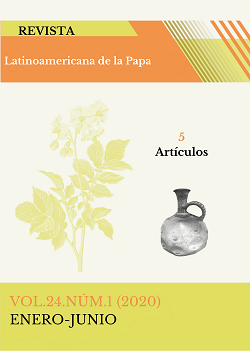Response of UCE-Premium and UCE Allipacha to Phytophthora infestans, Rhizoctonia solani and Pectobacterium sp.
##plugins.themes.bootstrap3.article.main##
Abstract
Potato crop in Ecuador is affected by different limitations of biotic origin among them late blight (Phytophthora infestans), rhizoctoniasis (Rhizoctonia solani) and blackleg (Pectobacterium sp). In recent years, these limitations have become important factor to the crop. The objective of this research was to evaluate the response of UCE Premium and UCE Allipacha with their respective controls (tolerant and susceptible) to these pathogens. For P. infestans, under field conditions the relative area under the progress curve of the disease (AUDPCr) was calculated and the lesion growth rate (LGT) and the size of the lesion (TL) were measured in the laboratory. While, for rhizoctoniasis, incidence and yield were assessed. For blackleg, the tuber rot volume was evaluated and its resistance degree was established. INIAP Libertad and UCE Allipacha had lower ABCPEr in the field with values of 0.02 and 0.03, a LGT of 7.84 and 7.19 mm2 and a TL 54.87, 54.46 mm2 respectively. For R. solani, there was no effect on yield, for incidence INIAP-Puca Shungo and INIAP-Victoria showed the lowest values with 25.25% and 35.5%, respectively. The rot tuber volume of Pectobacterium sp for INIAP-Santa Catalina and INIAP- Victoria was 19.07 ml and 18.50 ml respectively, while UCE-Premium presented the lowest rot tuber volume 8.42 ml. There was variation in the response attack of these pathogens in the potato genotypes.
Keywords: infection severity, resistance components, plant breeding, resistance, roots
Download Statistics
##plugins.themes.bootstrap3.article.details##

This work is licensed under a Creative Commons Attribution-NonCommercial-ShareAlike 4.0 International License.


 https://orcid.org/0000-0002-9826-1406
https://orcid.org/0000-0002-9826-1406